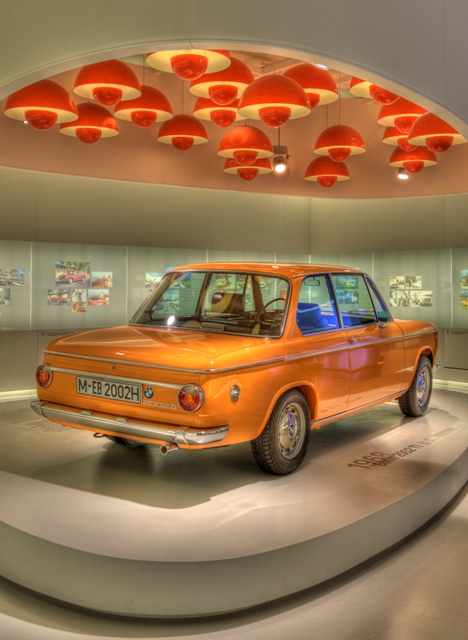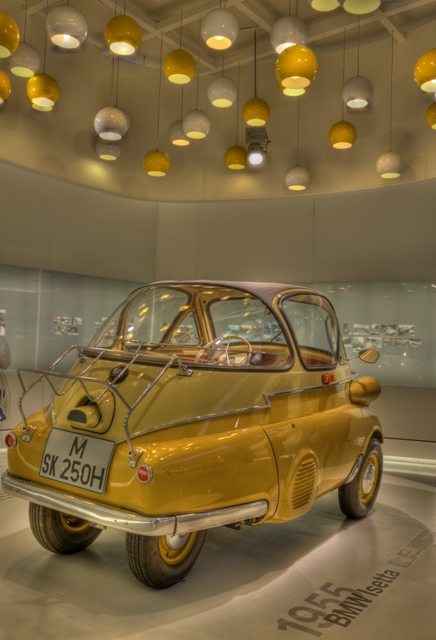At this point in our walk through the BMW museum, we've seen the motorcycles, the M-series room, and the section with luxury & cabriolet models. Now for something completely different.
Another area shows two beloved BMW models from the 50s and 60s. The theme is how cars are part of our lives -- walls are filled with photos of people with their BMWs, often families travelling through Germany, Austria, & Italy.
First is the BMW 2002Ti. It's the forerunner to the modern 3-series, and from 1968-1976 defined the concept of a compact 2-door sports sedan. Notice the car + lifestyle photos on the walls in the background:
 BMW 2002TI (1968)
BMW 2002TI (1968)
The next model was designed in Italy after World War II for a continent that still had low productive capacity and really needed only cheap short-distance transportation. It's a "microcar" -- a small, egg-shaped body that uses a scooter/motorcycle engine! It was called the Isetta.
The Isetta measures only 7.5 feet long by 4.5 feet wide. It has a single bench seat inside (for 2 adults), and heater was optional. Ventilation? Open the fabric sunroof!
The two-cylinder engine produced 9.5hp, and was connected to a 4-speed manual transmission. The rear wheels are only two feet apart! The base is so narrow that it didn't need a differential.
Its producer licensed the design all over Europe, and between 1953 and 1962 it was made in different forms in Spain, Belgium, France, Germany, and even Brazil. It kept some car companies from bankruptcy.
 BMW Isetta (1955)
BMW Isetta (1955)
The Isetta would take 30 seconds to reach 30mph, on its way to a "top speed" of 47mph. But it got at least 50 miles (reported up to 70) to the gallon. And parking is a breeze.
Here's a test: We'll show a few more photos of the Isetta. Do you see anything... missing or unusual?
Look at the passenger's side:
Now look at the driver's side:
How does the driver enter the car???
Here's the driver's side from another angle:
Did you figure it out?
The answer comes from one of the old photos on the wall:
You enter the car from the front door! You can see the handle better in the photo below.
The steering wheel and entire instrument panel swung out with the door. What happens in the event of a front-end collision? Passengers were told to exit through the sunroof!
First prototypes had only one rear wheel, but that made the car prone to tipping over - therefore a second wheel was added. Eventually, different models emerged including a flatbed pickup version, a truck, and a fire engine.
Most of the info above pertains to the original Italian version of the Isetta. When BWM licensed the design and tooling, they re-engineered it to use their own one-cylinder four-stroke motorcycle engine that delivered 13hp (+30% more). In fact, none of the parts between the BMW version and the Italian model are interchangeable.
BMW first produced their Isetta in 1955, and by 1962 had sold over 161,000 units -- the top selling single-cylinder car in the world.
There is only one topic left from the trip to the BMW museum... coming soon.